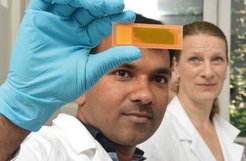A Quick Test for the Black Death
A sugar-based detection method enables easy and accurate identification of the Yersinia pestis bacterium

Diagnosing the presence of Yersinia pestis, the cause of the plague, may soon be easier than ever before. Scientists working with Peter Seeberger, Director at the Max Planck Institute of Colloids and Interfaces in Potsdam-Golm, developed a simple, inexpensive and reliable test for detecting the bacterium.
The researchers first identified and synthesized an oligosaccharide (complex sugar) found on the bacterial surface, before combining it with a protein to heighten its immunological effect.
The resulting glycoprotein can locate the pathogen in two ways, the first being to act as an antigen and detect Yersinia pestis in the blood of infected patients. However, the Potsdam-based scientists also used it to generate antibodies that can detect the plague pathogen directly in infected tissue.
(Angewandte Chemie International Edition, online, July 10, 2013)
